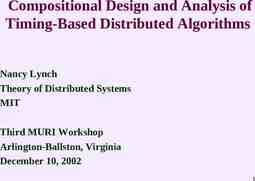De DCOM à .Net Stéphane Frenot – Département Télécommunication – SID
17 Slides85.50 KB

De DCOM à .Net Stéphane Frenot - Département Télécommunication - SID - stephane.frenot@insa- II - Dcom 1

DCOM : Solution microsoft Propriétaire – Intégrée avec d'autres produits Microsoft (architecture DNA : Distributed Network Architecture) COM ActiveX MTS MQS – Fonctionne sur plusieurs plates-formes NT/95 Unix Stéphane Frenot - Département Télécommunication - SID - stephane.frenot@insa- II - Dcom 2

Le document DDE : Dynamic Data Exchange – Service de transmission de messages pour faire communiquer deux applications (1992) – Complexe uniquement implanté sur Excel OLE1 : Object Linking & Embedding – Repose sur DDE – Copier/coller OLE2 (1993) – Activation In-Situ Stéphane Frenot - Département Télécommunication - SID - stephane.frenot@insa- II - Dcom 3

DCOM : Motivations Développement et évolution d'applications réparties sur des machines hétérogènes – Mécanismes "transparents" d'appel à distance Réutilisation de code – Réutilisation de composants binaires exécutables Pas d'accès au code source Association d'interfaces multiple à un composant binaire – Mécanisme de composition Construction de composants à partir de composants existants Evolution dynamique – Remplacement de composants (sans recompilation ou édition de liens) – Association de nouvelles interfaces – Capacité d'auto-description Stéphane Frenot - Département Télécommunication - SID - stephane.frenot@insa- II - Dcom 4

DCOM: Distributed Component Object Model DCE : Architecture distribuée COM (Component Object Model) le modèle d'objet composant (1996) Active-X: élément graphique actif que l'on peut assembler ou inclure dans des documents DCOM: utilisation d’un modèle RPC de DCE pour les communications entre objets (1997) (Ms)IDL: langage de définition d'interfaces .net / DNA / Hailstorm Stéphane Frenot - Département Télécommunication - SID - stephane.frenot@insa- II - Dcom 5

COM Approche binaire des objets Un objet COM : – publie une et une série d'interfaces – possède au moins une interface IUnknown qui possède une méthode QueryInterface qui possède des méthode de gestion du cycle de vie (Addref(), Release()) – chaque interface présente un GUID 3 familles de composants – in-process, local, distant Stéphane Frenot - Département Télécommunication - SID - stephane.frenot@insa- II - Dcom 6

COM est une fondation simple Instanciation / Publication Appels RPC Contrôle de fonctionnement mémoire Nommage (moniker) Stockage persistant Transfert uniforme de données (flux) Automation Stéphane Frenot - Département Télécommunication - SID - stephane.frenot@insa- II - Dcom 7

La bibliothèque COM Elle fournit une API pour la gestion des composants – – – – – – – Initialisation et terminaison Allocation et libération de la mémoire Génération des GUID (identificateurs uniques) Accès à la base de registres (GUID -- Noms) Création des composants Enregistrement des fabriques de classes Bibliothèque pour emballage et déballage des paramètres Stéphane Frenot - Département Télécommunication - SID - stephane.frenot@insa- II - Dcom 8

La base de registre Base de donées permettant d'associer noms et GUID – CLSID - Nom de fichier contenant le code d'implantation {0003DF 098} -- C:\ProgramFiles\Internet\iexplore.exe – Nom familier(Progid)-- CLSID Explorer.Appli 2-- {0003DF 098} Autres fonctions de désignation et recherche – Informations sur configuration, usagers, etc – Informations utiles pour la répartition (cf. DCOM) Stéphane Frenot - Département Télécommunication - SID - stephane.frenot@insa- II - Dcom 9

COM, ActiveX et OLE ActiveX Documents Activation in situ Contrôles Liaison Incorporation Documents composites Glisser relâcher COM Transfert uniforme de données Stockage persistant OLE Mise en script Monikers Automation Modèle d'objet composant Stéphane Frenot - Département Télécommunication - SID - stephane.frenot@insa- II - Dcom 10

DCOM CLIENT Application Cliente SERVEUR Souche COM Composant COM Proxy objet COM distant Proxy objet COM local Processus Client Souche COM Composant COM Processus serveur Exécutable COM Composant DCE RPC Sécurité Protocole de comm Stéphane Frenot - Département Télécommunication - SID - stephane.frenot@insa- II - Dcom 11

CInsideDCOM AddRef ISum Release Sum IUnknown QueryInterface Sum Cfactory IClassFactory CreateInstance LockServer AddRef Release QueryInterface Stéphane Frenot - Département Télécommunication - SID - stephane.frenot@insa- II - Dcom 12

Exemple de code import "unknwn.idl"; [object, uuid(10000001-0000-0000-0000-000000000001] interface Isum:Iunknown{ HRESULT Sum([in] int x, [in] int y, [out, retval]int * retval); }; Stéphane Frenot - Département Télécommunication - SID - stephane.frenot@insa- II - Dcom 13

Les étapes d'appel d'un service 1) Créer un composant (CLSID) 2) Obtenir un pointeur d'interface (IID) 3) Appel d'une méthode – fonction de l'interface 4) Terminer – Gestion de la mémoire Stéphane Frenot - Département Télécommunication - SID - stephane.frenot@insa- II - Dcom 14

Exemple de code client void main(){ Iunknown * pUnknown; Isum * pISum; HRESULT hr CoInitialize(NULL); if(FAILED(hr)) cout "CoInitialize failed." endl; const CLSID CLSID InsideDCOM {0x10000002,0x0000,0x0000,{0x00,0x00,0x00, 0x00,0x00,0x00,0x01}}; /*1*/ hr CoCreateInstance(CLSID InsideDCOM, NULL, CLSCTX INPROC SERVER, IID Iunknown, (void**)&pUnknown); if (FAILED(hr)) cout "CoCreateInstance failed." endl; /*2*/ hr pUnknown- QueryInterface(IID Isum, (void**)&pSum); if (FAILED(hr)) cout "IID Isum not supported." endl; pUnknown- Released(); int sum; /*3*/ hr pSum- Sum(2,3,&sum); if(SUCCEED(hr)) cout "Client: Calling Sum(2,3) » sum endl; /*4*/ pSum- Released(); CoUninitialize(); } Stéphane Frenot - Département Télécommunication - SID - stephane.frenot@insaII - Dcom 15

Conclusion sur DCOM Produit "propriétaire" – Lié à l'environnent Microsoft Environnement de développement spécifique (Visual ) Intégration aux autres outils – Office, Serveur Web IIS, IE, etc Interconnexion possible sur CORBA – Outil puissant, mais concepts difficiles à appréhender Spécifications opaques Héritage d'OLE – Nombreux composants diffusés Windows / VB . Stéphane Frenot - Département Télécommunication - SID - stephane.frenot@insa- II - Dcom 16

Références G. Eddon, H. Eddon, Au cœur de Distributed COM, Microsoft Press France, 1998 R. Grimes, Professional DCOM Programming, Wrox Press, Canada, 1997 Pointeurs – Microsoft – http://www.sente.ch/cetus/OO ole.html – http://research.microsoft.com/ ymwang/papers/HTML/DCOMnCORBA/ S.html – http://www.execpc.com/ gopalan/misc/compare.html Stéphane Frenot - Département Télécommunication - SID - stephane.frenot@insa- II - Dcom 17






